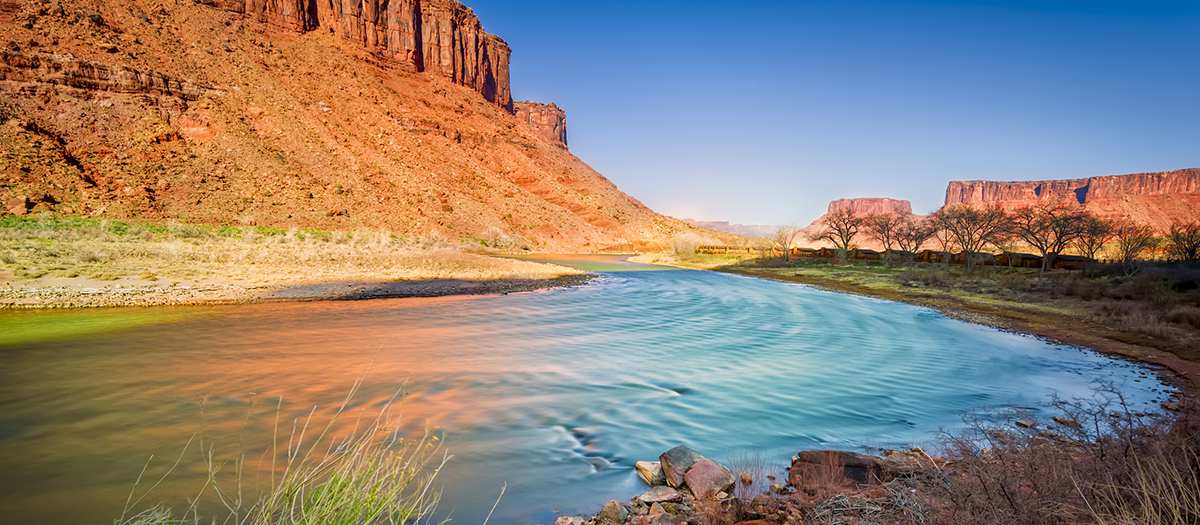Southern Nevada's water supply comes from a combination of Colorado River water and groundwater.
The Colorado River
Southern Nevada gets nearly 90 percent of its water from the Colorado River, which begins as snowmelt in the Rocky Mountains.
The snowmelt travels through a series of tributaries into the river, which winds its way south for 1,450 miles and empties into the Gulf of California in Mexico.
Seven western states and Mexico share the river, which serves more than 25 million people.
More about the Colorado River
Learn more about the river and the plan for our community's future on SNWA.com:
Groundwater
About 10 percent of the Las Vegas Valley's water comes from groundwater, which is a water supply under the Earth's surface.
The Las Vegas Valley Water District pumps groundwater from wells to meet peak summer demand. During the hot summer months from June through September, groundwater can account for up to 25 percent of the valley's daily water supplies.
Where does groundwater come from?
Groundwater occurs as part of the hydrologic cycle, which is the movement of water between the earth and the atmosphere through evaporation and precipitation. The underground area where groundwater exists is referred to as an aquifer.
Groundwater in the Las Vegas Valley comes from three major aquifer zones, generally situated from 300 to 1,500 feet below land surface. This drinking-water supply is protected from surface contamination by a layer of clay and fine-grained sediments throughout most of the valley.
Occasionally, news reports mention that contaminants such as pesticides and fertilizers have been found in groundwater. These reports typically refer to water in the shallow groundwater system, water that occurs within 50 feet of land surface. It is separated from the primary producing aquifers by thick layers of clay and fine-grained sediments. This shallow groundwater water is not used for drinking water.
Who uses groundwater?
While the Water District uses groundwater to augment its supply, businesses and residents using community and domestic wells rely on groundwater 100 percent of the time. There are more than 6,000 wells within the Las Vegas Valley that provide groundwater year-round to residents and other users who aren't on a municipal water supply.
What is the Southern Nevada Groundwater Bank?
One of the keys to maintaining a stable, reliable water supply is diversifying the community's sources of water. Among the key components in the Southern Nevada Water Authority's water resource portfolio is the Southern Nevada Groundwater Bank, a massive "natural" storage facility beneath the Las Vegas Valley.
Beginning in 1987, the Las Vegas Valley Water District and City of North Las Vegas, as SNWA member agencies, began injecting treated Colorado River water from Lake Mead into the valley's primary aquifer in years when Nevada's Colorado River allocation exceeded demand.
In the years since the program began, the Water District and the City of North Las Vegas collectively have stored more than 360,000 acre-feet of water for the community's use in times of need. That equates to roughly 117 billion gallons of water.
Currently, LVVWD has 52 dedicated and dual-use recharge/recovery wells – predominantly in the northwest part of the valley – with a total injection capacity of about 100 million gallons per day.
Although it might seem tempting to forego conservation measures and simply withdraw some of that stored water from the groundwater bank during periods of drought, it is very important that the community keep these reserves on hand for an emergency or as a bridge to future resources. Maintaining a healthy balance in the Southern Nevada Groundwater Bank provides assurances to the community that we are prepared to weather an extended drought.
While the Southern Nevada Groundwater Bank is a resource upon which the community can draw in times of need, it has also been used by the Las Vegas Valley Groundwater Management Program to permanently store Colorado River water for the benefit of the aquifer. By injecting water into portions of the valley where the water table is susceptible to decline, the Water Authority is able to maintain stable water levels and reduce the likelihood of subsidence and well failures.
The Las Vegas Wash
Less than 2 percent of Lake Mead's water comes from the Las Vegas Wash, but it is of particular interest to the Las Vegas Valley Water District for the unique role it plays in the valley's ecological picture.
The Wash is a tributary that channels stormwater, urban runoff, shallow groundwater and highly-treated wastewater into the Las Vegas Bay at Lake Mead.
The Wash is a natural wetlands and its marshy qualities help polish impurities from water that flows through it and into Lake Mead. In addition, the wetlands area is home to a variety of plant and animal species.
As a member agency of the Southern Nevada Water Authority, the Water District assists in programs to help protect and restore the Las Vegas Wash. These programs have included building weirs – dam-like structures – and revegetating shoreline to help strengthen the Wash banks and reduce erosion.
Learn More at LVWash.org